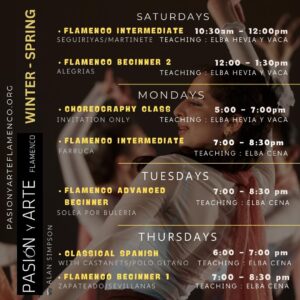Classes
In 2008, Hevia y Vaca also launched the PyA Conservatory to provide a disciplined environment for preserving and teaching the formal structures of flamenco in an emotionally supportive environment. Hevia y Vaca is senior adjunct at Franklin & Marshall and at Temple University. She continuously teaches courses at local schools, colleges and universities and is often students’ first encounter with this dance form.
Classes will all be taught by Elba Hevia y Vaca at the Overbrook Garage Studio in Philadelphia, unless otherwise indicated.
Cost is $17 for drop in or $90 for a 6 class card. Discounts for students and dance professionals are available upon request.
All the levels will involve the study of:
- Colocacion (The Flamenco Posture): body work, placement and understanding center, arm and hand exercises
- Footwork: exercises and drills in relations to the compas (rhythm) and palos (rhythm family)
- Music: The compas or rhythm of flamenco is the key musical element that unites the three fundamental forms of expression that make up flamenco: toque (guitar) cante and baile and is essential in learning and creating this art form. Flamenco consists of various palos, the difference between them lies predominantly in the rhythm structure and melody. We will study the structure through phrase work and rhythm training with palmas.
A brief history of Flamenco
Flamenco’s origins come from a mixture of many cultures, the most important being Muslim, Jewish, Indo-Pakistani and Byzantine. Many flamencologos (Flamenco historians) believe that Flamenco as we know it today did not develop until the sixteenth century, when the kingdom of Castilla decided to rid Spain of minority groups in an effort to propagate pureness of race and religion. All Jews and Muslims that refused to convert to Christianity were expelled from the country and all gypsies who would not leave the open road and settle down were expelled as well. As a consequence, these three persecuted cultures, with very little in common, found themselves united against a common foe. It is probable that from the common life of these persecuted peoples that the first semblances of Flamenco as we know it began. Muslim, Jewish, Indian, and Christian religious and folk music blended, developing over the years into a musical form all its own.
Many historians believe the world “Flamenco” is a mispronunciation of the Arabic words “felag” and “mengun” which means fugitive peasants. It is likely that this term was borrowed from the Arabs (which was the common language in Andalusia at that time) and applied to all persecuted people who fled to the mountains. Through usage in Spanish, “felagmengu” was transformed into “Flamenco” until the term Flamenco was adopted by the fugitives themselves and in turn applied to their music. The main form at that time, was the “cante jondo” which expressed the suffering of these outlawed oppressed people, who through the years were condemned to serve in the galleys, in chain gangs, and in the Spanish army. They were prohibited to speak their own languages and many were killed. Somehow their spirit remained unbroken, and their mode of expression– their Flamenco- -developed to magnificent heights throughout the centuries, culminating in the Café Cantante period of the last century.
Flamenco dance as we now know it is an expressive art form that has a ritual significance. It is a mixture and fusion with elements from several different cultures. Therefore, Flamenco has a diverse range of melodies, rhythms, and structures that together express the deeper and more complex feelings of the human being with each “palo” expressing an emotion.
Today, Flamenco consists of:
- Cante- song
- Dance- baile
- Toque- guitar playing
- Jaleo- rhythm accentuation and reciting

